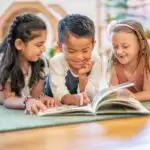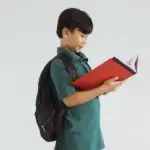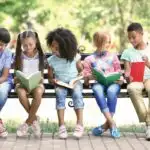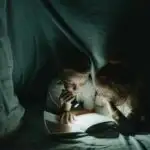In fourth grade, children are at a critical stage in their reading development, becoming more independent readers while still benefiting from read-aloud experiences.
Read-aloud books in the classroom or at home offer a wonderful opportunity to engage students in captivating stories, foster a love for reading, and enhance their comprehension skills.

In this article, we will explore a curated selection of the best read-aloud books for fourth graders.
So join us as we delve into a world of literary treasures that will leave fourth graders eagerly awaiting the next read-aloud session!
1. The Girl Who Drank The Moon By Kelly Barnhill
“The Girl Who Drank The Moon” by Kelly Barnhill is a captivating and enchanting fantasy novel that is perfect for fourth-grade read-aloud sessions.
Set in a world where magic and mystery abound, the story revolves around Luna, a young girl with a magical past who becomes the unwitting target of the wicked witch Xan.
Xan, however, instead of harming Luna, accidentally gives her extraordinary powers.
Pros
- Captivating storytelling
- Rich imagery and world-building
- Themes of identity and empowerment
Cons
- The book deals with themes of loss, sacrifice, and confronting darkness. Some readers, especially those who are more sensitive or prefer lighter stories, may find certain aspects of the book intense or emotionally challenging.
2. A Wolf Called Wander By Roseanne Parry
This next book is a heartwarming middle-grade novel inspired by the true story of a young wolf’s incredible journey across the wilderness.
The book follows the courageous and resilient wolf named Swift as he navigates various challenges and encounters both friend and foe.
Pros
- Engaging and unique perspective
- Authentic and educational
- Emotional depth
Cons
- The book’s pacing can be considered slower, as it focuses on the gradual development of Swift’s character and his journey. Some readers who prefer fast-paced action may find the story less gripping.
3. Mario And The Hole In The Sky: How A Chemist Saved Our Planet By Elizabeth Rusch
Next up is an engaging and informative children’s book that introduces young readers to the world of chemistry, environmental science, and the importance of taking action to protect our planet.
The book tells the true story of Mario Molina, a Mexican chemist who discovered the damaging effects of chlorofluorocarbons (CFCs) on the Earth’s ozone layer.
Pros
- Educational and informative
- Offers the chance for kids to learn about environmental issues and awareness
- Based on an inspiring true story
Cons
- The book delves into scientific concepts and terminology related to chemistry and the ozone layer, which may be challenging for some young readers who are not familiar with the topic. Additional explanations or discussions may be needed to ensure understanding.
4. The Lion, The Witch, And The Wardrobe By C.S. Lewis
“The Lion, the Witch, and the Wardrobe” by C.S. Lewis is a timeless and beloved children’s fantasy novel that takes readers on a magical journey to the enchanting land of Narnia.
This book, the first in “The Chronicles of Narnia” series, follows the adventures of four siblings – the eldest Peter, Susan, Edmund, and the youngest sibling Lucy – as they step through a wardrobe into a world filled with talking animals, mythical creatures, and an epic battle between good and evil.
Pros
- Captivating and imaginative storytelling
- Memorable characters
- Enduring appeal
Cons
- Some readers may interpret elements of the story as a religious allegory, which could be either a pro or a con depending on personal beliefs. Educators and parents may want to be aware of this aspect and consider how it aligns with their own values or educational objectives.
5. Roll with It By Jamie Sumner
This next book follows the story of Ellie, a spunky and determined 12-year-old girl with cerebral palsy.
The book explores themes of family, friendship, and the power of resilience as Ellie navigates the challenges of a new town and school while confronting prejudice and misconceptions about her disability.
Pros
- Authentic representation of disability
- Empowering and relatable protagonist
- Heartwarming family dynamics
Cons
- The overall plot structure of “Roll with It” follows a familiar pattern commonly found in middle-grade novels. Some readers may find the plot predictable or wish for more unexpected twists.
6. Charlie And The Chocolate Factory By Roald Dahl
Roald Dahl’s classic and enchanting children’s book that has captivated readers for decades.
The story follows the adventures of Charlie Bucket, a young boy from a humble background, who wins a golden ticket to tour the magical and eccentric Willy Wonka’s chocolate factory.
Pros
- An imaginative and magical world.
- Themes of morality and character.
- Memorable characters
- Humor and wit
Cons
- Some readers may find that the book relies on stereotypes in its portrayal of certain characters, such as the spoiled and gluttonous Augustus Gloop or the materialistic Veruca Salt. It is important to address these portrayals and have discussions about the potential impact of stereotypes.
7. Snow & Rose By Emily Winfield Martin
“Snow & Rose” by Emily Winfield Martin is a charming and enchanting middle-grade fantasy novel that puts a unique twist on the classic fairy tale of Snow White and Rose Red.
The story follows the adventures of two sisters, Snow and Rose, as they navigate a magical forest filled with secrets, dangers, and unexpected discoveries.
Pros
- Magical and atmospheric setting
- Exploration of sisterly bonds
- Themes of courage and resilience
- Whimsical illustrations
Cons
- As a reimagining of Snow White and Rose Red, the book incorporates familiar fairy tale elements. While this can be enjoyable for fans of classic tales, readers seeking completely original storytelling may find it less appealing.
8. The One and Only Ivan By Katherine Applegate
Next up is this heartwarming and poignant middle-grade novel inspired by a true story. The book follows the life of Ivan, a gorilla living in captivity at a shopping mall circus.
Through Ivan’s perspective, the story explores themes of friendship, empathy, and the importance of fighting for what is right.
Pros
- Unique and engaging narration
- Emotional impact
- Accessible writing style
Cons
- The book delves into themes of captivity and animal mistreatment, which may be emotionally challenging for some readers. It is important for parents or educators to be aware of these themes and provide support or guidance during discussions.
9. Wonderstruck By Brian Selznick
“Wonderstruck” is a captivating and visually stunning middle-grade novel that tells a dual narrative through both words and intricate illustrations.
The book weaves together two stories set 50 years apart, following the journeys of two children, Ben and Rose, as they search for connection, identity, and a sense of belonging.
Pros
- Unique format
- Engaging dual narrative
- Strong themes of identity and belonging
Cons
- The dual narratives and shifting timelines in “Wonderstruck” require readers to pay close attention to the details and connections between the two storylines. This complexity may be more challenging for younger or less experienced readers.
10. The Boy Who Harnessed The Wind By William Kamkwamba
This next book is a remarkable and inspiring memoir that tells the true story of a young Malawian boy who overcame adversity to bring electricity and hope to his village.
The book details William’s journey from his childhood in a rural farming community to becoming a self-taught engineer and inventor.
Pros
- An inspirational true story
- Educational in that it highlights the challenges faced by its inhabitants, particularly in terms of access to education, healthcare, and basic resources.
- The book offers readers a glimpse into Malawian culture and traditions, providing an opportunity to learn about a different way of life and fostering a sense of empathy and cultural understanding.
Cons
- As the book delves into William’s engineering projects and inventions, it occasionally includes technical terminology and descriptions that may be challenging for younger readers.
11. The Lightning Thief By Rick Riordan
“The Lightning Thief” by Rick Riordan is the first book in the popular “Percy Jackson & The Olympians” series.
It follows the adventures of Percy Jackson, a twelve-year-old boy who discovers that he is a demigod – the son of Poseidon, the Greek god of the sea.
The book takes readers on an action-packed journey through Greek mythology as Percy embarks on a quest to prevent a war among the gods.
Pros
- Engaging blend of mythology and contemporary setting
- Relatable characters
- Fast-paced and action-packed
Cons
- While the book is generally suitable for middle-grade readers, some parents or educators may find certain elements, such as intense action scenes or references to violence, more suitable for older readers.
12. Harry Potter And The Sorcerer’s Stone By J.K. Rowling
A timeless classic, “Harry Potter and the Sorcerer’s Stone” follows the magical journey of Harry Potter.
Harry is an orphan who- on his eleventh birthday- finds out that he is a wizard and is invited to attend Hogwarts School of Witchcraft and Wizardry.
The book introduces readers to a rich and enchanting world filled with adventure, friendship, and the battle between good and evil.
Pros
- An immersive, magical world
- Memorable characters
- Engaging plot with mystery
- Themes of friendship, bravery, and identity.
Cons
- The book has a complex plot and numerous characters, so less experienced readers may find the length and complexity challenging.
13. One-Third Nerd By Gennifer Choldenko
“One-Third Nerd” by Gennifer Choldenko is a heartwarming and humorous middle-grade novel that follows the story of a young boy named Liam, his two younger sisters, and their German Shepherd dog Cupcake.
The book explores themes of family, friendship, and perseverance as the characters navigate challenges and find their own unique strengths.
Pros
- Lighthearted and humorous.
- A realistic portrayal of everyday life.
- Engaging characters.
- Positive portrayal of Downs Syndrome via Liam’s sister Izzy.
Cons
- While the main characters are well-developed, some readers may find that secondary characters could have been further explored and developed.
14. Holes By Louis Sachar
Next is a captivating and award-winning novel that follows the story of Stanley Yelnats, a young boy who is sent to Camp Green Lake, a juvenile detention center, as punishment for a crime he did not commit.
The book explores themes of friendship, justice, and the power of fate, weaving together past and present narratives to unravel the mysteries surrounding Camp Green Lake.
Pros
- A unique and intriguing plot
- Skillful use of flashback and storytelling
- Themes of friendship and redemption
Cons
- “Holes” delves into serious themes such as injustice, racism, and abuse. Some readers, particularly those who are more sensitive, may find certain aspects of the story challenging or unsettling.
15. Where The Mountain Meets The Moon by Grace Lin
Last but not least, this novel by Grace Lin is a beautifully written and enchanting story that weaves together Chinese folklore, adventure, and a heartwarming story of family and self-discovery.
The book follows the journey of a young girl named Minli who lives with her parents in a ramshackle hut.
After hearing stories of the Old Man on the Moon and the Jade Dragon from her father, Minli embarks on a quest to find the Old Man of the Moon so that she can change her family’s fortune.
Pros
- Rich cultural and folklore elements
- Themes of family, courage, and determination
- Imaginative and engaging storytelling
Cons
- The book’s narrative structure, which interweaves Minli’s journey with various folktales, can be complex for some readers to follow.
You may also like: Best Books For Fifth Graders
Buyers Guide
So there you have fifteen particularly noteworthy choices when it comes to books that are well suited for a fourth-grade read-aloud session.
Let’s now take a look at some of the factors to consider when choosing a fourth grade read-aloud book.
Age Appropriateness
Ensure that the book is suitable for fourth-grade students in terms of language, content, and complexity.
Consider the reading level and maturity of the students to ensure they can comprehend and engage with the story.
Interest And Engagement
Look for books that align with the student’s interests, hobbies, or curiosities.
Consider their preferences for genres, themes, or topics to ensure they are excited and engaged during the read-aloud sessions.
Length And Structure
Consider the length of the book and the attention span of fourth-grade students. Choose a book that can be comfortably read aloud within the desired timeframe, allowing for discussion and reflection.
Consider the chapter structure as well, as shorter chapters can provide natural stopping points for discussion and reflection.
Diversity And Representation
Choose books that offer diverse perspectives and representation, including characters from different backgrounds, cultures, or experiences.
This can help promote empathy, understanding, and cultural appreciation among students.
Readability And Read-Along Appeal
Consider the book’s read-aloud appeal, including its rhythm, dialogue, and engaging storytelling.
Look for books that lend themselves well to oral reading, allowing for expressive and engaging read-aloud sessions.
Educational Value
Consider the educational value of the book. Look for books that can spark discussions, explore themes, or offer opportunities for interdisciplinary learning.
Think about the potential connections to curriculum subjects such as history, science, or social studies.
Availability And Accessibility
Ensure that the chosen book is readily available, whether through the school library, local library, or as a classroom resource.
Consider the accessibility of the book in terms of affordability, multiple copies, or digital formats if needed.
Price
Determine the budget available for purchasing books. Consider whether the budget allows for purchasing multiple copies if needed or if there are any other resources available, such as borrowing from the school or local library.
Final Thoughts
Selecting the best books for fourth-grade read-aloud sessions involves careful consideration of various factors.
Ultimately, the best books for fourth-grade read-aloud sessions are those that captivate young minds, inspire meaningful discussions, and create lasting memories.
By selecting thoughtfully chosen books, educators can make read-aloud sessions a cherished and enriching part of the fourth-grade experience, fostering a love for literature and empowering students on their journey of learning and growth!
Frequently Asked Questions
What Genres Are Recommended For Fourth-Grade Read-Aloud Books?
Fourth graders enjoy a wide range of genres, including adventure, fantasy, historical fiction, mystery, and realistic fiction.
Are There Any Specific Themes Or Topics That Work Well For Fourth-Grade Read-Aloud Books?
Fourth graders are at an age where they can explore complex themes and topics.
Books that touch on themes such as friendship, family, resilience, identity, diversity, and social issues can spark meaningful discussions and promote empathy and understanding among students.
- Homeschooling In High School: Pros And Cons - February 24, 2024
- How Do I Withdraw My Child From School To Homeschool? - February 23, 2024
- How To Not Go Crazy Homeschooling Kids: A Guide For Frazzled Parents - February 22, 2024









Leave a comment